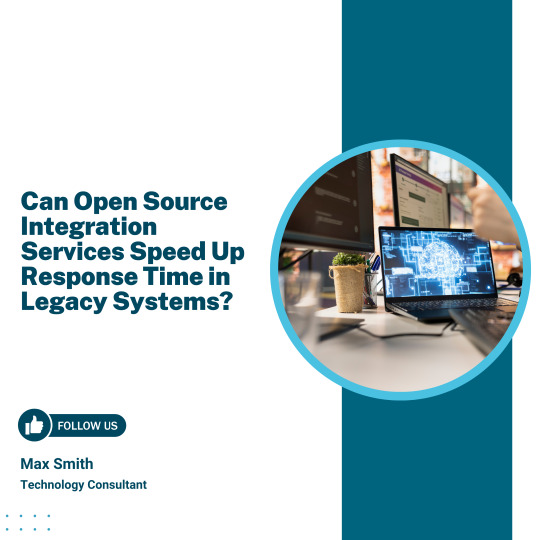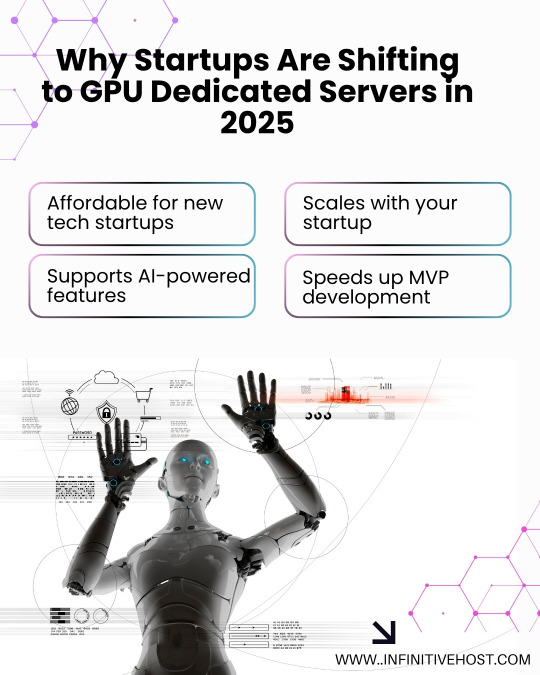#ITInfrastructure
Explore tagged Tumblr posts
Text
Can Open Source Integration Services Speed Up Response Time in Legacy Systems?
Legacy systems are still a key part of essential business operations in industries like banking, logistics, telecom, and manufacturing. However, as these systems get older, they become less efficient—slowing down processes, creating isolated data, and driving up maintenance costs. To stay competitive, many companies are looking for ways to modernize without fully replacing their existing systems. One effective solution is open-source integration, which is already delivering clear business results.

Why Faster Response Time Matters
System response time has a direct impact on business performance. According to a 2024 IDC report, improving system response by just 1.5 seconds led to a 22% increase in user productivity and a 16% rise in transaction completion rates. This means increased revenue, customer satisfaction as well as scalability in industries where time is of great essence.
Open-source integration is prominent in this case. It can minimize latency, enhance data flow and make process automation easier by allowing easier communication between legacy systems and more modern applications. This makes the systems more responsive and quick.
Key Business Benefits of Open-Source Integration
Lower Operational Costs
Open-source tools like Apache Camel and Mule eliminate the need for costly software licenses. A 2024 study by Red Hat showed that companies using open-source integration reduced their IT operating costs by up to 30% within the first year.
Real-Time Data Processing
Traditional legacy systems often depend on delayed, batch-processing methods. With open-source platforms using event-driven tools such as Kafka and RabbitMQ, businesses can achieve real-time messaging and decision-making—improving responsiveness in areas like order fulfillment and inventory updates.
Faster Deployment Cycles: Open-source integration supports modular, container-based deployment. The 2025 GitHub Developer Report found that organizations using containerized open-source integrations shortened deployment times by 43% on average. This accelerates updates and allows faster rollout of new services.
Scalable Integration Without Major Overhauls
Open-source frameworks allow businesses to scale specific parts of their integration stack without modifying the core legacy systems. This flexibility enables growth and upgrades without downtime or the cost of a full system rebuild.
Industry Use Cases with High Impact
Banking
Integrating open-source solutions enhances transaction processing speed and improves fraud detection by linking legacy banking systems with modern analytics tools.
Telecom
Customer service becomes more responsive by synchronizing data across CRM, billing, and support systems in real time.
Manufacturing
Real-time integration with ERP platforms improves production tracking and inventory visibility across multiple facilities.
Why Organizations Outsource Open-Source Integration
Most internal IT teams lack skills and do not have sufficient resources to manage open-source integration in a secure and efficient manner. Businesses can also guarantee trouble-free setup and support as well as improved system performance by outsourcing to established providers. Top open-source integration service providers like Suma Soft, Red Hat Integration, Talend, TIBCO (Flogo Project), and Hitachi Vantara offer customized solutions. These help improve system speed, simplify daily operations, and support digital upgrades—without the high cost of replacing existing systems.
2 notes
·
View notes
Text
turkish man🐱türkischer Mann🐱Турецкий мужчина türk erkekleri English subtitled 😾🙀😹
dailymotion
#funny poems#funny memes#funny post#funny shit#funny#fuck school#artists on tumblr#cats of tumblr#free palestine#art#arcane#formula 1#sonic the hedgehog#japan#jujutsu kaisen#severance#uykusuzlukbelirtisi#germany#video games#black canary#ying anada#canadian#canada#united kingdom#happy#manchester united#united states#itinfrastructure#iyi ve güzel kadınlar hep ağlar#iyi akşamlar
6 notes
·
View notes
Text

Why Startups Are Shifting to GPU Dedicated Servers in 2025
Startups need speed—GPUs deliver it at scale.
📞 US Toll-Free No.: +1 888-544-3118 ✉️ Email: [email protected]
🌐 Website: https://www.infinitivehost.com/gpu-dedicated-server
📱 Call (India): +91-7737300013
🚀 Get in touch with us today for powerful GPU Dedicated Server solutions!
#GPUDedicatedServer#GPUHosting#HighPerformanceComputing#AIPowered#DeepLearning#MachineLearning#AIInfrastructure#TechStack#CloudGPU#ServerHosting#AIDevelopment#CryptoMining#GameDevelopment#3DRendering#VideoEditing#BigData#ScientificComputing#AutonomousVehicles#HealthcareAI#CloudGaming#TechTrends#DigitalTransformation#CloudComputing#SaaSInfrastructure#StartupTech#ITInfrastructure#CloudSolutions
1 note
·
View note
Text
IT Infrastructure - 7 Best Practices You Need to Know
IT infrastructure management has become one of the key components for the smooth operation of businesses in the rapidly evolving digital era. It has become crucial for businesses of all sizes to adopt a reliable IT framework that can handle the growing modern business complexities.
The global IT Infrastructure monitoring market will reach a whopping amount of $21.72 billion by 2034. Thus, to ease day-to-day operations and enhance productivity and growth, it is necessary to implement best practices for IT infrastructure.
The physical devices in an organization, including storage systems, servers, routers, network infrastructure, and software components like databases, operating systems, and cloud computing, are a few key elements of an effective IT infrastructure.
#itinfrastructure#itinfrastructuremonitoring#networkinfrastructure#networksecurity#infrastructuremonitoringtool#infrastructuremonitoringsoftware
1 note
·
View note
Text
youtube
Get in-depth analysis of the Japan cloud managed services market report 2025! In this comprehensive report, we provide insights into the key trends, market dynamics, and growth opportunities shaping the Japan cloud managed services industry. Whether you're a industry professional, an investor, or looking to know about the market trends, this report is your go-to resource.
Key Highlights:
Market Overview: Get insights into the historical and forecast data of the Japan cloud managed services market Market Trends and Drivers: Explore the latest trends and factors influencing market sector, fund size, and funding type. Industry Segment Analysis: Understand Industry Segmentation the market based on device type, platform, revenue type, type, and age group. Regional Analysis: Get regional Insights and market dynamics impacting different geographical areas. Competitive Landscape: Read about comprehensive overview of key players, their strategies, and market positioning. Report Edition: 2025-2033
Who Should Watch?
Industry Professionals Investors and Stakeholders Researchers and Analysts Food and Beverage Enthusiasts Business Owners and Entrepreneurs
Report Links: https://www.imarcgroup.com/japan-cloud-managed-services-market
Follow us on LinkedIn: https://www.linkedin.com/company/imarc-group/
Youtube Link: https://youtu.be/aaRcyCyOXIw
Contact Us: IMARC Group 134 N 4th St. Brooklyn, NY 11249, USA Email: [email protected] Tel No: (D) +91 120 433 0800 USA - +1 201971-6302
#JapanCloudServices#ManagedServices#CloudComputing#DigitalTransformation#Cybersecurity#HybridCloud#AIinCloud#CloudInnovation#ITInfrastructure#TechTrends2025#Youtube
0 notes
Text

Omada Gateways Reliable Performance for Every Business
Omada Gateways deliver reliable, high-performance connectivity tailored for every business size. Engineered for stability and efficiency, they ensure seamless network access and enhanced security. Trust Omada Gateways to keep your business connected, productive, and ready for growth—every day.
For more information, Visit:https://newtrend.ae/product-category/tplink/ Live chat: +971 507542792
#OmadaGateways#ReliableConnectivity#BusinessNetworking#NetworkSecurity#HighPerformance#SeamlessConnection#TechSolutions#BusinessGrowth#NetworkStability#EfficientNetworking#TPLink#SmartBusiness#ITInfrastructure#ConnectedBusiness#NetworkInnovation#TechForBusiness#BusinessTech#EnterpriseNetworking#SecureNetworks#DigitalTransformation
0 notes
Text
How to Simplify Your IT Infrastructure in 2025
Explore effective ways to reduce IT complexity and streamline infrastructure for better efficiency.
0 notes
Link

The global Application Delivery Controllers (ADCs) market is set to double by 2030, fueled by virtual ADC growth, security integration, and cloud-native deployment. Explore key trends, forecasts, and leading vendors like F5, Citrix, and Fortinet.
#ADCs#CloudNative#ApplicationSecurity#F5Networks#CitrixADC#APISecurity#ITInfrastructure#DevOps#WAF#HybridCloud
0 notes
Text
NOC vs SOC

NOC and SOC might sound similar, but they play very different roles in IT. NOC (Network Operations Center) keeps systems running smoothly, while SOC (Security Operations Center) focuses on protecting them from threats. This blog breaks down their core functions, differences, and how both teams work together to keep your digital infrastructure strong and secure. A must-read for tech enthusiasts and IT pros alike.
0 notes
Text
Digital Twins Driving Operational Efficiency in IT
The evolution of IT operations has taken a transformative leap forward with the emergence of digital twins. While this technology may not always make front-page headlines, its impact is profound, silently reshaping how IT infrastructure is monitored, managed, and optimized. How Digital Twins Are Quietly Disrupting IT Operations has become a key topic among technology leaders seeking smarter, predictive, and more resilient systems.

A digital twin is a virtual replica of a physical object, process, or system that can simulate real-time performance, identify potential failures, and test solutions before they are applied in the physical world. This innovation is revolutionizing industries across the board, but nowhere is its influence more understated yet revolutionary than in IT operations.
What Are Digital Twins and Why Do They Matter in IT?
Digital twins were initially developed for industrial applications such as manufacturing and aerospace. However, as the IT ecosystem has become more complex, the need for real-time monitoring, predictive analytics, and simulation tools has grown. Enter the digital twin — a powerful ally that enables IT teams to mirror entire data centers, networks, and applications digitally.
How Digital Twins Are Quietly Disrupting IT Operations stems from their ability to provide actionable insights without interfering with live systems. IT administrators can simulate outages, test patches, and analyze workloads under different conditions, all within the virtual realm.
Predictive Maintenance and Proactive Monitoring
One of the most compelling uses of digital twins in IT is predictive maintenance. Traditional IT monitoring tools can only react after an issue occurs. In contrast, digital twins anticipate issues by modeling the current and future state of systems.
For example, if a digital twin detects that a server’s performance is degrading under increased load, it can alert the team before a failure happens. This foresight reduces downtime and improves service continuity — a vital capability in mission-critical environments.
By adopting digital twins, organizations are transforming their IT operations from reactive to proactive, one of the most significant ways how digital twins are quietly disrupting IT operations.
Enhanced Change Management
Change management in IT is often a delicate balancing act. Whether it’s rolling out a new application, upgrading infrastructure, or modifying configurations, changes can lead to unintended consequences. Digital twins offer a sandbox environment to simulate these changes in a controlled manner.
This capability is especially beneficial in enterprise IT, where the risk of downtime can translate into massive revenue loss. By modeling changes beforehand, organizations can forecast their effects on the overall system and refine their approach before implementation.
This simulation-based planning is another strong indicator of how digital twins are quietly disrupting IT operations by minimizing change-related risks and enhancing operational agility.
Improving Cybersecurity Posture
Cybersecurity threats are more sophisticated than ever, and traditional defenses often fall short of predicting new attack vectors. Digital twins are changing the game by offering a real-time, immersive view of the IT environment.
Cybersecurity teams can use digital twins to simulate potential attack paths, assess the strength of their defenses, and uncover vulnerabilities before they are exploited. Moreover, these virtual models can be used to train security personnel in realistic environments without exposing actual infrastructure to risks.
In this way, how digital twins are quietly disrupting IT operations includes a strong contribution to more robust and predictive cybersecurity frameworks.
Optimizing Resource Allocation and IT Infrastructure
Managing resources efficiently is always a challenge in IT. Whether it’s server utilization, bandwidth distribution, or storage provisioning, misallocation can cause bottlenecks and cost overruns.
Digital twins help IT managers analyze usage patterns and test different allocation scenarios to determine the most efficient setup. For instance, they can simulate what would happen if more bandwidth is allocated to a business-critical application or how a new hardware configuration might affect database performance.
These capabilities demonstrate how digital twins are quietly disrupting IT operations by aligning infrastructure with actual business needs and usage trends.
Enhancing Incident Response and Root Cause Analysis
When an IT issue arises, quickly identifying the root cause is crucial to minimizing downtime. Digital twins accelerate this process by offering a visual, real-time representation of system behavior and dependencies.
For example, if a network outage occurs, the digital twin can replay events leading up to the failure, highlighting anomalies and pinpointing the source. This drastically reduces the mean time to resolution (MTTR) and helps IT teams learn from incidents more effectively.
This streamlined troubleshooting process is yet another example of how digital twins are quietly disrupting IT operations behind the scenes.
Supporting Hybrid and Multi-Cloud Environments
As businesses adopt hybrid and multi-cloud strategies, IT operations become more decentralized and complex. Monitoring and managing these environments with traditional tools can be cumbersome and inefficient.
Digital twins offer a unified view of both on-premise and cloud assets, enabling real-time synchronization and deeper insights across environments. They facilitate the orchestration of services, ensure compliance, and optimize workload distribution seamlessly.
This centralized visibility makes digital twins indispensable for modern IT environments and underscores how digital twins are quietly disrupting IT operations in cloud-centric architectures.
Data-Driven Decision Making in IT
The rise of digital twins aligns with the broader shift toward data-driven decision-making. These virtual models are rich in telemetry, generating data that can be analyzed for trends, anomalies, and optimization opportunities.
CIOs and IT leaders can use digital twin data to make strategic decisions regarding infrastructure investments, system upgrades, or security enhancements. Having a digital replica that evolves with the actual system ensures that decisions are based on accurate, up-to-date information.
This analytical power represents one of the core ways how digital twins are quietly disrupting IT operations, enabling IT to function as a strategic business enabler.
Fostering Collaboration Across IT Teams
Another often-overlooked benefit of digital twins is the collaboration they foster across departments. From DevOps to SecOps and NetOps, various teams can interact with a shared digital representation of the infrastructure.
These cross-functional interactions break down silos, encourage knowledge sharing, and lead to more cohesive operational strategies. Teams can jointly review simulations, run tests, and align on solutions — all within the safe, virtual environment of the digital twin.
This cultural shift in collaboration is a critical piece of how digital twins are quietly disrupting IT operations, not just technologically but organizationally.
The Role of AI and Machine Learning
Digital twins become even more powerful when combined with AI and machine learning. These technologies can analyze data from the digital twin, identify hidden patterns, and automate responses to predicted issues.
For example, if machine learning algorithms detect that a particular server configuration consistently leads to memory spikes, they can recommend or even implement an optimized setup automatically. This convergence of AI and digital twins is supercharging IT automation.
It’s impossible to overstate how digital twins are quietly disrupting IT operations by turning AI-driven insights into proactive interventions and ongoing self-optimization.
The Future of IT Operations with Digital Twins
As digital twins continue to evolve, their influence on IT operations will only deepen. From predictive monitoring and performance tuning to risk assessment and training, these virtual environments are becoming essential tools in the modern IT toolkit.
Their ability to mirror, simulate, and optimize complex systems silently is precisely how digital twins are quietly disrupting IT operations — not with fanfare, but with tangible, lasting results.
Read Full Article : https://bizinfopro.com/blogs/it-blogs/how-digital-twins-are-quietly-disrupting-it-operations/
About Us : BizInfoPro is a modern business publication designed to inform, inspire, and empower decision-makers, entrepreneurs, and forward-thinking professionals. With a focus on practical insights and in‑depth analysis, it explores the evolving landscape of global business—covering emerging markets, industry innovations, strategic growth opportunities, and actionable content that supports smarter decision‑making.
0 notes
Text

#SAPCloud#CloudReliability#EnterpriseCloud#SAPExperts#DigitalTransformation#CloudSolutions#ITInfrastructure#SecureCloud#ScalableSolutions#SAPSupport#CloudOptimization#BusinessContinuity#ProphecyTechs#CloudInnovation
0 notes
Text
Unlocking OEM Software Updates – Why They Matter
By RAVINDRA BALAJI PUTTEWAR
For many organizations, especially those operating in sectors like manufacturing, healthcare, energy, or logistics, OEM (Original Equipment Manufacturer) software updates can feel like background noise—one of those things you’ll “get to later.” But ignoring or delaying these updates can quietly lead to breakdowns, inefficiencies, and even security breaches.
At ADITI IT SERVICES PVT LTD, we’ve seen firsthand how OEM software updates aren’t just patches or cosmetic tweaks—they’re vital to performance, stability, and the long-term value of your investment.
Let’s break down why these updates matter and how businesses can take full advantage of them.
What Are OEM Software Updates?
OEM software updates are improvements or fixes provided by the original manufacturer of your hardware or embedded systems. These could apply to:
Servers and storage systems
Networking devices (routers, switches, firewalls)
Industrial machines with embedded controls
Medical equipment with integrated software
POS systems and kiosks
Surveillance and access control devices
Updates might include:
Performance enhancements
Security patches
Compatibility with new protocols
Bug fixes
Feature upgrades
Regulatory compliance changes
Why Businesses Tend to Overlook Updates
Let’s be honest: when your systems are “working just fine,” updates don’t feel urgent. And in many environments, updates are mistakenly seen as:
A nuisance that risks downtime
An IT cost rather than a performance asset
Something only needed “if something breaks”
This mindset can lead to systems running outdated firmware or software for years—until a vulnerability is exploited or a critical process fails.
The Risks of Ignoring OEM Updates
Here’s what’s really at stake when you skip or delay updates:
1. Security Gaps
Cybercriminals often target known vulnerabilities that manufacturers have already patched. If your system isn't updated, you're essentially leaving the door unlocked.
2. System Instability
Unpatched bugs can lead to random errors, crashes, or strange behavior—especially when newer software is layered on top of older firmware.
3. Loss of Support
Many OEMs tie their service SLAs or warranties to update compliance. Running outdated versions can void your support coverage or delay resolution in case of failures.
4. Missed Efficiency Gains
OEMs routinely optimize performance, energy use, or resource management through updates. You could be missing out on improved throughput or lower operating costs.
5. Compatibility Issues
When you integrate new hardware, cloud platforms, or software, old firmware may block compatibility, leading to costly workarounds or full replacements.
How ADITI Helps Clients Stay Ahead
We believe updates shouldn’t feel like a burden. At ADITI IT SERVICES PVT LTD, we build proactive update management into every IT and telecom support plan we offer.
Our approach includes:
Inventory auditing to identify outdated systems
Risk analysis before applying updates
Scheduled update windows to avoid disruptions
Rollback planning in case something goes wrong
OEM coordination to ensure proper licensing and support
Documentation and compliance reporting for audits or certifications
This helps clients in regulated industries (like BFSI, healthcare, or government) maintain system integrity while avoiding unnecessary delays or cost overruns.
One Update Made a Big Difference
Recently, one of our clients in the logistics space faced intermittent failures in their barcode scanning system. The OEM support team pointed to a known issue—patched six months earlier. The client hadn’t installed the update.
We helped them implement it during off-hours, and just like that, the issue disappeared. No hardware replacement needed. No extended downtime. Just an overlooked fix—now resolved.
Looking Ahead: Smarter, Safer Infrastructure
As digital transformation accelerates, OEM software updates are no longer optional—they’re strategic. They protect your uptime, enhance performance, and extend the life of your investments.
And if you’re juggling hundreds of devices across multiple branches or remote sites, we can help build a centralized update policy that’s automated, compliant, and easy to monitor.
A Global Perspective
As a proud nominee for the 2025 Go Global Awards in London, ADITI IT SERVICES PVT LTD continues to empower Indian enterprises with world-class IT solutions. Our recognition by the International Trade Council affirms our dedication to building scalable, secure, and modern infrastructures for tomorrow’s digital world.
Final Thought
OEM software updates are like servicing your car—they keep things running smoothly, prevent costly surprises, and ensure you get the full value from your investment. Don’t let them be an afterthought.
If you haven’t checked your systems in a while, now might be the time to ask—what are we missing out on?
#OEMUpdates#ITInfrastructure#SecureSystems#AditiITServices#EnterpriseSupport#SoftwareLifecycle#EmbeddedSystems#TechReliability#GoGlobalAwards#RavindraBalajiPuttewar
0 notes
Text
A Complete Guide to WordPress Themes with WordPress Hosting
Designing a quick, functional, and visually appealing WordPress site always begins with two big decisions — choosing the perfect theme and securing trustworthy WordPress hosting. While themes determine how your website looks, your hosting environment affects how it functions. In this comprehensive guide, we’ll check out how to choose, optimize, and handle themes with the help of top-notch WordPress hosting, mainly when powered by GPU servers and handled by professionals at Infinitive Host.
#GPUDedicatedServer#GPUHosting#HighPerformanceComputing#AIPowered#DeepLearning#MachineLearning#AIInfrastructure#TechStack#CloudGPU#ServerHosting#AIDevelopment#GameDevelopment#3DRendering#VideoEditing#AutonomousVehicles#CloudGaming#TechTrends#CloudComputing#StartupTech#ITInfrastructure#CloudSolutions
1 note
·
View note
Text
Data Center Asset Management Market Set to Achieve USD 9,924.99 Million by 2034 | CAGR: 15.2%
Data Center Asset Management Market Analysis: Opportunities, Innovations, and Growth Potential Through 2034 Global Data Center Asset Management Market size and share is currently valued at USD 2,419.42 million in 2024 and is anticipated to generate an estimated revenue of USD 9,924.99 million by 2034, according to the latest study by Polaris Market Research. Besides, the report notes that the…
#AssetManagement#CloudInfrastructure#DataCenter#DataCenterManagement#DataCenterSecurity#DCIM#DigitalInfrastructure#EdgeComputing#ITAssetTracking#ITInfrastructure#NetworkManagement#ServerOptimization#SmartDataCenters#TechSolutions
0 notes
Text
Server Management: A Complete Guide for Businesses
In today’s digital-first world, server management is a critical aspect of maintaining a reliable, secure, and high-performing IT infrastructure. Whether you’re running a small business website or a large-scale enterprise application, efficient server management ensures smooth operations, minimizes downtime, and enhances security.
What is Server Management?
Server management refers to the process of monitoring, maintaining, and optimizing servers to ensure they operate efficiently. This includes hardware and software management, security updates, performance tuning, and troubleshooting.
Key Components of Server Management:
Hardware Monitoring – Checking CPU, RAM, disk usage, and temperature. Software Updates – Applying OS patches, security fixes, and application updates. Security Management – Firewalls, intrusion detection, and malware protection. Backup & Disaster Recovery – Regular data backups and recovery plans. Performance Optimization – Load balancing, caching, and resource allocation. User & Access Control – Managing permissions and authentication.
Why is Server Management Important?
Prevents Downtime – Proactive monitoring reduces unexpected crashes. Enhances Security – Protects against cyber threats and data breaches. Improves Performance – Optimized servers ensure faster response times. Cost Efficiency – Reduces hardware failures and unnecessary expenses. Compliance – Helps meet industry regulations (GDPR, HIPAA, etc.).
Types of Server Management
1. On-Premises Server Management
Managed in-house by an IT team.
Full control over hardware and software.
Higher upfront costs but more customization.
2. Cloud Server Management
Managed via cloud providers (AWS, Azure, Google Cloud).
Scalable, flexible, and cost-effective.
Requires expertise in cloud platforms.
3. Hybrid Server Management
Combines on-premises and cloud servers.
Balances security, performance, and cost.
4. Managed Hosting Services
Outsourced to third-party providers.
Ideal for businesses without an IT team.
Best Practices for Effective Server Management
Automate Routine Tasks – Use scripts for backups, updates, and monitoring. Monitor Server Health – Tools like Nagios, Zabbix, or Prometheus help track performance. Implement Strong Security – Use firewalls, SSL certificates, and regular audits. Schedule Regular Backups – Ensure data recovery in case of failures. Optimize Resource Usage – Balance workloads to prevent bottlenecks. Document Configurations – Maintain logs for troubleshooting and audits.
Top Server Management Tools
🛠 Monitoring: Nagios, SolarWinds, Datadog 🛠 Automation: Ansible, Puppet, Chef 🛠 Security: Fail2Ban, Snort, Wazuh 🛠 Backup: Veeam, Acronis, Rsync
In-House vs. Outsourced Server Management
AspectIn-HouseOutsourcedCostHigher (hardware & staff)Pay-as-you-goControlFull controlLimited customizationExpertiseRequires skilled IT teamManaged by expertsScalabilityLimited by hardwareHighly scalable
When Should You Consider Professional Server Management?
Your business is growing, and server demands are increasing.
You lack an experienced IT team.
Security and compliance are top priorities.
Frequent downtime is affecting operations.
Final Thoughts
Effective server management is crucial for business continuity, security, and performance. Whether you manage servers in-house or outsource to experts, following best practices ensures a stable and secure IT environment.
Need help managing your servers? Consider managed hosting or cloud solutions to streamline operations and focus on growing your business!
0 notes
Text

DAP-X3060OU
AX3000 Wi-Fi 6 Outdoor PoE Access Point
Centralized management through on-premises software (Nuclias Connect).
This empowers network managers to analyze, automate, configure, optimize, scale, and secure their network.
For more information,
Visit:https://newtrend.ae/product-category/dlink/
Live chat: +971 507542792
#DLink#Nuclias#DAPX3060OU#WiFi6#OutdoorWiFi#PoEAccessPoint#AX3000#DLinkMiddleEast#DLinkUAE#NucliasConnect#NetworkSolutions#WirelessNetworking#EnterpriseWiFi#OutdoorAccessPoint#BusinessConnectivity#SmartNetworking#ITInfrastructure#NetworkSecurity#ManagedWiFi#WiFiTechnology#TechSolutions#NewtrendUAE
0 notes